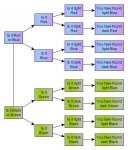RoyLittle0
Active member
How can i add data to a listview from a xml file, i want to add two columns to the list view, i can add data to a listbox but i cant seem to do the same to a listview, the data i need to add is from a xml file, which is "id" and "Name" in two separate columns, they are part of a cascading set of 12 listview boxes each dependent on the one above and i need the id to implement the next cascade.
There are 12 list views in total, so i assume i need to define what goes into each of the columns, can this be done globally for all listviews?
The below code has been modified for listboxes to give me the additional column but i cant seem to get it to work in listview
any pointers would be appreciated
There are 12 list views in total, so i assume i need to define what goes into each of the columns, can this be done globally for all listviews?
The below code has been modified for listboxes to give me the additional column but i cant seem to get it to work in listview
any pointers would be appreciated
VB.NET:
Private Sub Form1_Load(ByVal sender As System.Object, ByVal e As System.EventArgs) Handles MyBase.Load
ListBoxes.AddRange({Solution1, Solution2, Solution3, Solution4, Solution5, Solution6, Solution7, Solution8, Solution9, Solution10, Solution11, Solution12}) 'this has to be done here to ensure that the controls have initialised
doc = XDocument.Load(IO.Path.Combine(Application.StartupPath, "Test.xml"))
' This will fill solution box 1 with the Root 1 information from the xml file
Dim Root As New ListViewItem
(
From A In doc...<Section1>
Select Section1 = A.@id()
).ToArray
Solution1.Items.Add(Root)
End Sub
Private Sub Sloution1_Click(ByVal sender As System.Object, ByVal e As System.EventArgs)
Select Case ListBoxes.IndexOf(sender)
'Solution1.click event, fills Solution box 2 with values based on the information in Solution box 1
Case 0
Dim Root2 =
(
From a In doc...<Section1>
Where a.@id = Solution1.Text
From b In a.<Root2>.<Section2>
Select b.@id
).ToArray
Solution2.Items.Add(Root2)
'Solution2.click event, fills Solution box 3 with values based on the information in Solution box 2
Case 1
If Solution2.Items.Count > 0 Then
Dim Root3 =
(
From b In doc...<Section2>
Where b.@id = (Solution2.Text)
From c In b.<Root3>.<Section3>
Select c.@id
).ToArray
Solution3.Items.Add(Root3)
End If
'Solution3.click event, fills Solution box 4 with values based on the information in Solution box 3
Case 2
If Solution3.Items.Count > 0 Then
Dim Root4 =
(
From c In doc...<Section3>
Where c.@id = Solution3.Text
From d In c.<Root4>.<Section4>
Select d.@id
).ToArray
Solution4.Items.Add(Root4)
End If
'Solution4.click event, fills Solution box 5 with values based on the information in Solution box 4
Case 3
If Solution4.Items.Count > 0 Then
Dim Root5 =
(
From d In doc...<Section4>
Where d.@id = Solution4.Text
From f In d.<Root5>.<Section5>
Select f.@id
).ToArray
Solution5.Items.Add(Root5)
End If
'Solution5.click event, fills Solution box 6 with values based on the information in Solution box 5
Case 4
If Solution5.Items.Count > 0 Then
Dim Root6 =
(
From f In doc...<Section5>
Where f.@id = Solution5.Text
From g In f.<Root6>.<Section6>
Select g.@id
).ToArray
Solution6.Items.Add(Root6)
End If
'Solution6.click event, fills Solution box 7 with values based on the information in Solution box 6
Case 5
If Solution6.Items.Count > 0 Then
Dim Root7 =
(
From g In doc...<Section6>
Where g.@id = Solution6.Text
From h In g.<Root7>.<Section7>
Select h.@id
).ToArray
Solution7.Items.Add(Root7)
End If
'Solution7.click event, fills Solution box 8 with values based on the information in Solution box 7
Case 6
If Solution7.Items.Count > 0 Then
Dim Root8 =
(
From h In doc...<Section7>
Where h.@id = Solution7.Text
From i In h.<Root8>.<Section8>
Select i.@id
).ToArray
Solution8.Items.Add(Root8)
End If
'Solution8.click event, fills Solution box 9 with values based on the information in Solution box 8
Case 7
If Solution8.Items.Count > 0 Then
Dim Root9 =
(
From i In doc...<Section8>
Where i.@id = Solution8.Text
From j In i.<Root9>.<Section9>
Select j.@id
).ToArray
Solution9.Items.Add(Root9)
End If
'Solution9.click event, fills Solution box 10 with values based on the information in Solution box 9
Case 8
If Solution9.Items.Count > 0 Then
Dim Root10 =
(
From j In doc...<Section9>
Where j.@id = Solution9.Text
From k In j.<Root10>.<Section10>
Select k.@id
).ToArray
Solution10.Items.Add(Root10)
End If
'Solution10.click event, fills Solution box 11 with values based on the information in Solution box 10
Case 9
If Solution10.Items.Count > 0 Then
Dim Root11 =
(
From k In doc...<Section10>
Where k.@id = Solution10.Text
From l In k.<Root11>.<Section11>
Select l.@id
).ToArray
Solution11.Items.Add(Root11)
End If
'Solution11.click event, fills Solution box 12 with values based on the information in Solution box 11
Case 10
If Solution11.Items.Count > 0 Then
Dim Root12 =
(
From l In doc...<Section11>
Where l.@id = Solution11.Text
From m In l.<Root12>.<Section12>
Select m.@id
).ToArray
Solution12.Items.Add(Root12)
End If
End Select
End Sub
Last edited:

